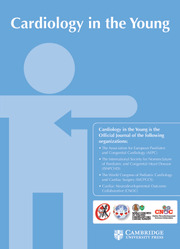No CrossRef data available.
Article contents
Evaluating patients with Kawasaki disease: can the systemic immune inflammation index predict coronary involvement?
Published online by Cambridge University Press: 14 October 2025
Abstract
Kawasaki disease is a self-limiting vasculitis of unknown aetiology, and coronary artery lesions are its most common and serious complication. The Systemic Immune-Inflammation Index is a new biomarker of inflammation that may have prognostic value in Kawasaki disease. This study evaluated patients with Kawasaki disease and the prognostic role of Systemic Immune-Inflammation Index in coronary involvement. A total of 62 children with Kawasaki disease and 49 healthy controls were included. Systemic Immune-Inflammation Index was calculated as: neutrophils × platelets/lymphocytes). Systemic Immune-Inflammation Index was also significantly higher in Kawasaki disease patients than controls (2373 ± 2040 vs. 300 ± 218, p < 0.001). Subgroup analysis of the Kawasaki disease patients showed that Systemic Immune-Inflammation Index was significantly higher in patients with coronary artery lesions than in those without (p < 0.05). In conclusion, Systemic Immune-Inflammation Index is a composite inflammatory biomarker easily obtained from routine blood parameters and may be an independent predictor of coronary artery involvement in Kawasaki disease.
Information
- Type
- Original Article
- Information
- Copyright
- © The Author(s), 2025. Published by Cambridge University Press


